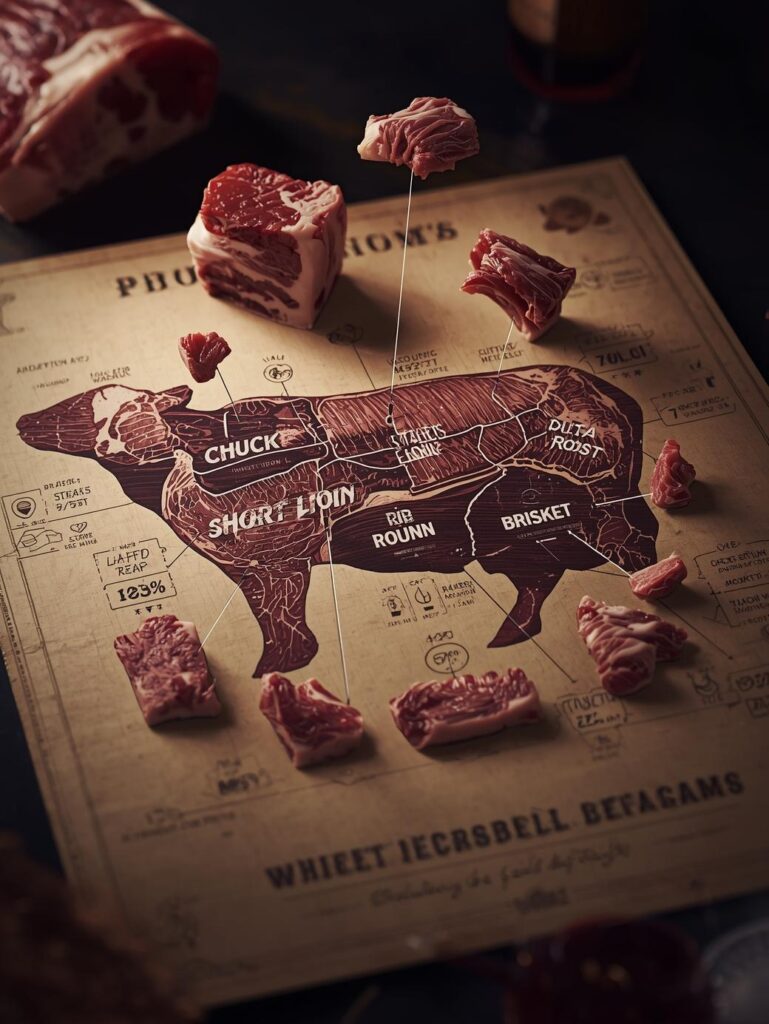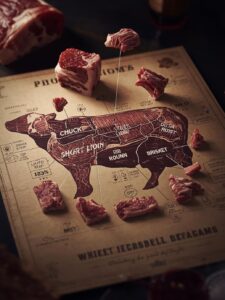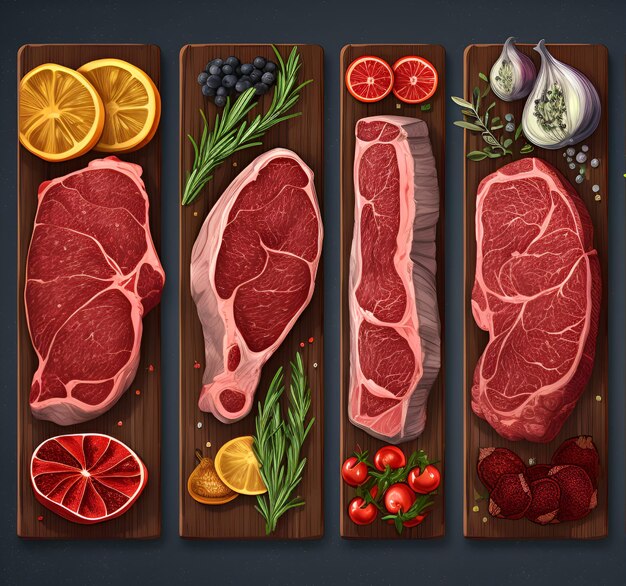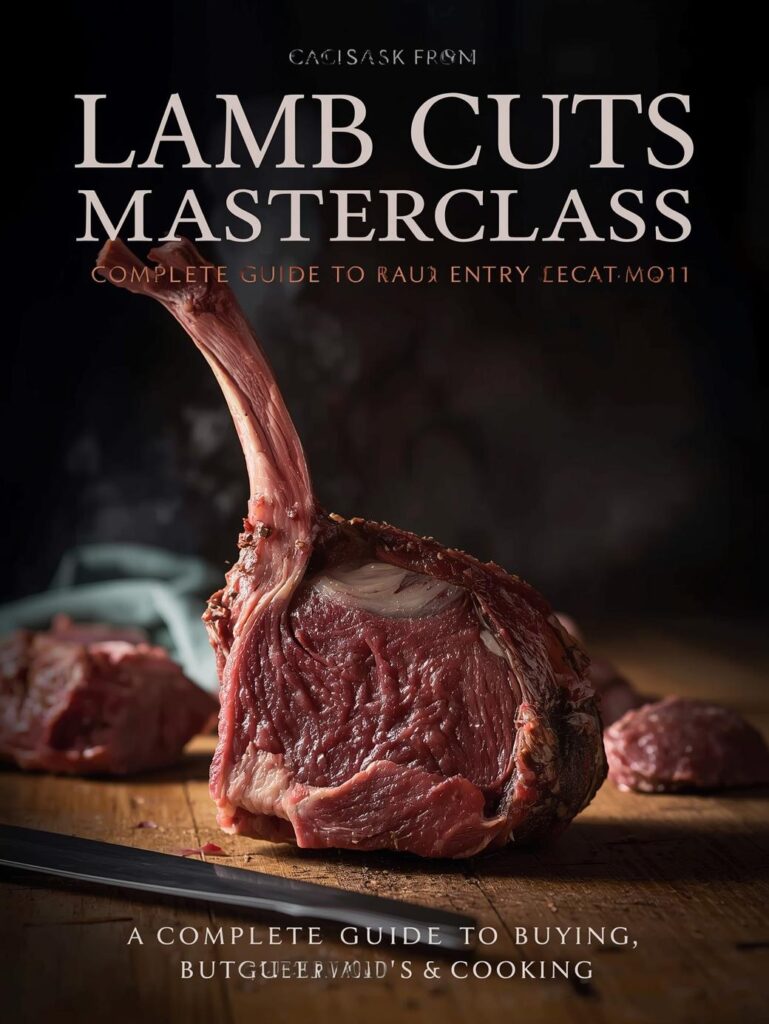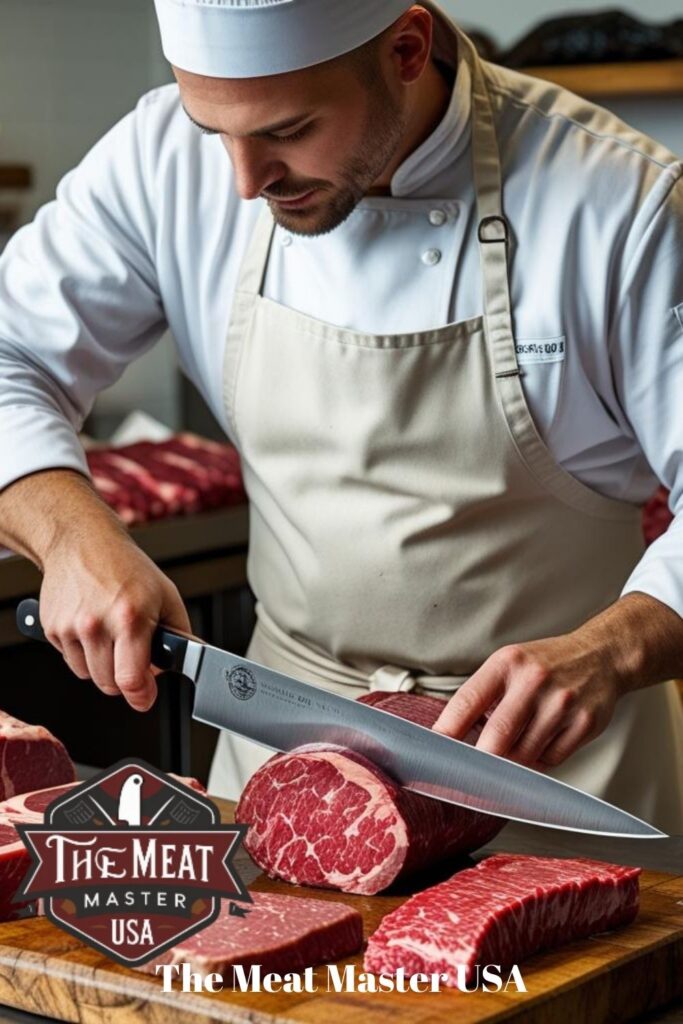Butcher’s Note: This guide represents the pinnacle of meat respect and utilization, building upon our comprehensive beef cuts library, pork mastery, and cutting techniques. Whole animal butchery isn’t just a skill—it’s a philosophy that honors the animal by wasting nothing. It’s where economy meets ethics, and where the true craftsman emerges from the cook.
Whole Animal Butchery: The Complete Nose-to-Tail Utilization Guide
“Whole animal butchery is the ultimate conversation between human and harvest. It’s understanding that every part has purpose, every cut tells a story of muscle function, and true respect means leaving nothing behind. When you break down a whole animal, you’re not just cutting meat—you’re reading anatomy, honoring life, and connecting to a tradition as old as civilization itself. The blood on your hands washes off; the knowledge in your mind transforms you forever.”
Whole Animal Butchery: Complete Nose-to-Tail Utilization Guide
Download the Whole Animal Yield Calculator - Cuts, Weights & Applications
Welcome to the sacred space between the hanging carcass and the perfect steak. Whole animal butchery is the final frontier for the serious meat enthusiast—the point where you transition from consumer to craftsman. This guide will take you through the complete breakdown of beef, pork, and lamb from nose to tail, teaching you not just where to cut, but why each cut exists and how to honor every part of the animal. This is more than cutting—it’s understanding, respecting, and maximizing one of nature’s most perfect resources.
🎯 THE WHOLE ANIMAL PHILOSOPHY: WHY NOSE-TO-TAIL MATTERS
Understanding the “why” is as important as mastering the “how.”
⚙️ The Four Pillars of Whole Animal Butchery
The Foundation of the Craft
- Maximum Utilization & Economy: Buying whole animals can save 40-60% compared to purchasing individual cuts. More importantly, you gain access to cuts most consumers never see—the oyster steak, the spider steak, the merlot cut—and transform inexpensive parts into extraordinary meals.
- Complete Flavor Understanding: When you work with the entire animal, you understand how different muscles work together, how fat distribution varies, and how to match cooking methods to each unique part. This knowledge transforms how you approach every cut, even when buying individually.
- Ethical Responsibility & Respect: Nose-to-tail utilization honors the animal’s life by ensuring nothing is wasted. It connects you directly to your food source and fosters a deeper appreciation for the meat you consume.
- Skill Development & Self-Sufficiency: Mastering whole animal butchery makes you independent. You’re no longer limited by what the grocery store decides to stock. You can create custom cuts, perfect thicknesses, and develop your own signature preparations.
🎯 Whole Animal vs. Individual Cuts: The Reality
🏪 Store Buying
- Pay premium for convenience
- Limited to popular cuts only
- Someone else’s cutting decisions
- No access to offal or bones
- Standardized thicknesses
- Higher cost per pound
🔪 Whole Animal
- 40-60% cost savings
- Access to 100% of the animal
- Your cutting preferences
- Free bones, fat, and offal
- Custom thicknesses
- Complete utilization
🔪 THE BEEF BREAKDOWN: PRIMAL TO PORTION
Mastering the quarter-ton bovine—the ultimate test of butchery skill.
🥩 The Eight Beef Primals: Roadmap of the Carcass
Navigating the Bovine Geography
- Chuck (Neck & Shoulder): The workhorse primal. Heavily exercised with complex muscle structure and abundant connective tissue. Contains classic cuts like chuck roast, flat iron steak, and Denver steak. Perfect for low-and-slow cooking or grinding.
- Rib (Forequarter): The luxury department. Minimal exercise results in exceptional tenderness and marbling. Home to ribeye steaks, prime rib, and short ribs. The spinalis dorsi (ribeye cap) is considered by many the single best bite of beef.
- Short Loin (Mid-Back): The tenderloin and strip section. Contains the most tender muscles in the animal—filet mignon, New York strip, and T-bone/Porterhouse steaks. Premium cuts that command premium prices.
- Sirloin (Hip): The transition zone between tender loin and working leg muscles. Contains sirloin steaks, tri-tip, and ball tip. Good balance of flavor and value.
- Round (Hind Leg): The lean, tough primal. Heavily exercised muscles ideal for roasting whole, cutting for stir-fry, or grinding. Contains top round, bottom round, and eye of round.
- Brisket & Shank (Chest & Leg): The toughest, most collagen-rich areas. Brisket transforms through low-and-slow smoking, while shanks become unctuous through braising.
- Plate & Flank (Belly): The flavorful, coarse-grained muscles. Skirt steak and hanger steak come from here—intensely beefy but requiring proper slicing against the grain.
📊 Whole Beef Yield & Utilization Matrix
🎯 From 600 lb Hanging Weight to Your Freezer (Approximate Yields)
| Cut Category | Weight Yield | Percentage | Primary Uses | Skill Level |
|---|---|---|---|---|
| Premium Steaks | 90-110 lbs | 15-18% | Grilling, pan-searing | Beginner |
| Roasts & Braising Cuts | 120-140 lbs | 20-23% | Oven roasting, slow cooking | Intermediate |
| Ground Beef | 80-100 lbs | 13-17% | Burgers, meatballs, sauces | Beginner |
| Soup Bones & Marrow | 40-50 lbs | 7-8% | Stock, bone broth, marrow | Intermediate |
| Organ Meats (Offal) | 25-35 lbs | 4-6% | Specialty dishes, pet food | Advanced |
| Fat & Suet | 30-40 lbs | 5-7% | Rendering, cooking fat | Intermediate |
| Trim & Loss | 175-215 lbs | 29-36% | Bone, cartilage, moisture loss | N/A |
🐖 THE WHOLE HOG BREAKDOWN: UTILIZING EVERY OUNCE
Pork offers the most diverse utilization of any animal—from head cheese to trotters.
🥓 The Pork Primal Mastery
From Snout to Tail
- Head & Jowl: The face and cheek meat. Jowl becomes guanciale (Italian bacon), while the head makes head cheese, braised cheeks, or stock. The ears become crispy treats.
- Shoulder (Boston Butt & Picnic): The BBQ champion. Perfect for pulled pork, sausage making, or Cuban-style roasting. Abundant fat and connective tissue transform through slow cooking.
- Loin: The premium section. Contains tenderloin, rib chops, and center-cut chops. Lean and tender, best for quick cooking methods. The backbone makes excellent stock.
- Belly & Spare Ribs: The flavor explosion. Pork belly becomes bacon or crispy roast belly. Spare ribs become St. Louis style ribs or country-style ribs.
- Leg & Ham: The celebration cut. Can be fresh roasted, cured for ham, or cut into steaks. The shank portion is perfect for osso buco.
- Feet (Trotters) & Hocks: The gelatin goldmine. Packed with collagen, they make incredible stock, add body to soups, or can be braised until tender.
- Offal & Trim: The hidden treasures. Liver for pâté, heart for grilling, kidneys for steak and kidney pie. Trim becomes sausage or ground pork.
🛠️ THE BUTCHER’S TOOLKIT: ESSENTIAL EQUIPMENT
The right tools don’t make the butcher, but the wrong ones will break you.
🔪 Cutting Tools
The Blades of the Trade
- Breaking Knife (8-10″): Your workhorse for primal separation. Stiff blade for cutting through joints and heavy muscle.
- Boning Knife (6″ Flexible): For detailed work around bones. The flexibility follows contours without wasting meat.
- Butcher’s Saw/Bandsaw: For cutting through bone. A hand saw works for occasional use; bandsaw for volume.
- Steel & Sharpening Stones: Sharp tools are safe tools. Learn proper knife maintenance.
- Cleaver (Optional): For chopping through small bones and portioning.
🏗️ Workspace & Safety
Setting Up for Success
- Butcher Blocks: Large, stable cutting surfaces. Plastic or wood, but avoid porous materials.
- Cutting Board Stability: Wet towel underneath prevents slipping during heavy work.
- Safety Equipment: Cut-resistant gloves, apron, non-slip shoes. Bloodborne pathogen awareness.
- Temperature Control: Keep meat at 34-38°F during processing. Work in batches if necessary.
- Packaging System: Vacuum sealer, freezer paper, labels. Organization is crucial.
🎯 THE BUTCHERY PROCESS: STEP-BY-STEP BREAKDOWN
A systematic approach to transforming carcass to cuts.
📋 The 8-Step Butchery Protocol
From Hanging to Packaged
- Assessment & Planning: Examine the animal. Identify fat coverage, muscling, any imperfections. Plan your cutting strategy based on your needs—steaks vs roasts, grinding vs whole muscle.
- Primal Separation: Divide into large sections following natural seams. For beef: separate into forequarter and hindquarter, then into the eight primals.
- Subprimal Breakdown: Further separate primals into manageable sections. Remove bones where appropriate (ribs, chine bone).
- Muscle Seam Butchery: Follow the natural seams between muscles. This preserves integrity and creates cleaner cuts. Use your fingers to feel where muscles separate.
- Fat & Silver Skin Removal: Trim excess external fat to ¼-inch if desired. Remove silver skin (connective tissue) that won’t break down during cooking.
- Final Portioning: Cut steaks to desired thickness, create roasts, prepare stew meat. Use consistent measurements for professional results.
- Grinding & Processing: Collect trim for grinding. Keep fat percentages consistent for different applications—80/20 for burgers, leaner for other uses.
- Packaging & Labeling: Vacuum seal or wrap with freezer paper. Label with cut, date, and weight. Organize for easy access.
The real treasures of whole animal butchery are the cuts that never make it to supermarket cases.
💎 The Butcher’s Secret Cuts
Extraordinary Cuts from Ordinary Animals
- Beef Oyster Steak (Spider Steak): From the hip, near the ball socket. Incredibly tender with complex grain structure. Only two per animal.
- Merlot Cut (Vacio Steak): From the flank, a beautifully marbled cut that’s tender with robust flavor. Popular in Argentine asado.
- Pork Coppa (Collar): The neck muscle, beautifully marbled. Can be roasted whole, cut into steaks, or cured for coppa.
- Lamb Rack Cap: The muscle covering the rib bones. Incredibly tender and flavorful when separated and grilled quickly.
- Beef Chuck Eye Roll: The continuation of the ribeye into the chuck. 80% of the flavor at 50% of the price.
- Pork Skirt Steak: From the diaphragm, similar to beef skirt but more tender. Excellent for quick grilling.
- Beef Teres Major: “The poor man’s tenderloin.” From the chuck, incredibly tender with minimal waste.
🍽️ OFFAL & SPECIALTY PARTS: THE ULTIMATE UTILIZATION
True nose-to-tail means honoring every organ and extremity.
🎪 Beyond Muscle Meat: The Complete Usage Guide
Nothing Wasted, Everything Honored
- Heart: Lean, dense muscle. Slice thin for quick grilling or braise whole. Incredible beefy flavor without gaminess.
- Liver: The nutrient powerhouse. Soak in milk to milden flavor, then pan-fry with onions or make pâté.
- Kidneys: Strong flavor that people love or hate. Essential for steak and kidney pie. Soak and blanch to reduce intensity.
- Tongue: Incredibly tender when braised. Peel the skin after cooking, slice, and serve with mustard or in tacos.
- Sweetbreads (Thymus): The ultimate delicacy. Soak, blanch, peel, then pan-fry or grill. Creamy, delicate texture.
- Bones: Roast for stock, make bone broth, or extract marrow. The foundation of great sauces and soups.
- Fat: Render for cooking fat (lard, tallow). Use for frying, roasting, or making confit.
- Feet & Trotters: The gelatin source. Add to stocks for body or braise until tender.
- Tail: Rich, gelatinous meat when braised. Oxtail is legendary for stews and soups.
🚨 WHOLE ANIMAL BUTCHERY TROUBLESHOOTING
🎯 Solving Common Whole Animal Challenges
| Problem | Symptoms | Cause | Solution |
|---|---|---|---|
| Uneven Cuts | Inconsistent thickness, wasted meat | Poor knife skills, rushing, wrong tools | Use cutting guides, measure thickness, practice basic cuts on cheaper meat first |
| Freezer Overload | Not enough space, disorganization | Poor planning, inadequate packaging | Plan cuts based on storage space, invest in vacuum sealer, label everything |
| Waste Concerns | Too much trim, unused parts | Lack of utilization knowledge | Learn grinding, stock making, charcuterie. Nothing should be wasted |
| Fatigue & Safety | Tiredness leading to mistakes, cuts | Trying to process too much at once | Work in 2-3 hour sessions, take breaks, use cut-resistant gloves |
| Yield Disappointment | Less meat than expected | Unrealistic expectations, poor animal selection | Understand hanging weight vs. finished yield. Choose well-finished animals |
🏁 THE COMPLETE BUTCHER’S MINDSET
Whole animal butchery is more than a skill—it’s a transformation in how you view meat, animals, and your place in the food chain. It’s the difference between being a consumer and being a craftsman. The first time you break down an entire animal yourself, something shifts. You’ll never look at a steak the same way again.
Start small—perhaps with a whole lamb or pig instead of a beef. Take a class if possible. Practice on less expensive animals first. But most importantly, begin. The knowledge you gain will transform not just your cooking, but your relationship with food itself.
The blood will wash off your hands. The soreness in your shoulders will fade. But the knowledge—the intimate understanding of anatomy, the respect for the animal, the confidence that you can feed yourself and your family from nose to tail—that remains forever.
Your journey to becoming a complete butcher begins with a single cut. Then a primal. Then a whole animal. Each step builds confidence, skill, and respect. The animal has given its life. Your job is to ensure that nothing—absolutely nothing—is wasted.
🔪 FIND WHOLE ANIMAL BUTCHERY CLASSES →
Hands-on learning from professional butchers in your area
Continue Your Butchery Education: Master every aspect of meat cutting and utilization.

